Claussen Pickles are kosher dill pickles at their crunchiest, saltiest best! These homemade Claussen pickles taste like the commercial ones you find at the store, but better. And better yet, they’re ridiculously easy to make!
Whether you’re new to pickle making or a pickle veteran, you NEED to make these half sour pickles! And wonder of wonders, you don’t need to know how to can to make these super fresh, crunchy pickles! Claussen dill pickles are meant to be eaten fresh.
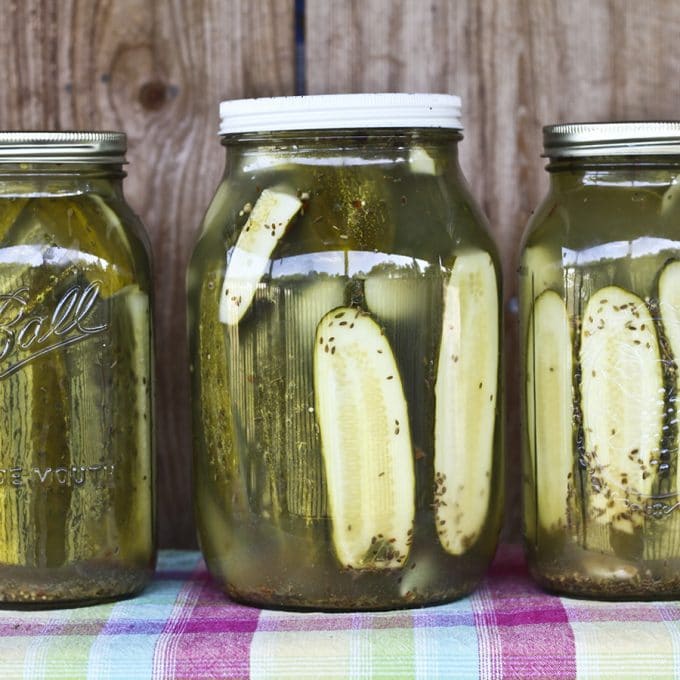
Homemade Claussen Knock-Off Pickles: Always crunchy and garlicky, this perfect homemade pickle recipe requires no special equipment, & no canning experience.
It’s common knowledge that I have a salty tooth rather than a sweet tooth. When the weather does what it has been doing lately (making us all do our best Shadrach, Meshach and Abednego impersonations) I can’t think of a single thing I find more refreshing than an icy-cold, salty, crunchy pickle.
It’s not just me, it’s my whole family: mother, sisters, brothers, cousins, aunts, grandparents, kids, husband… I married a man who loves pickles so much he eats the pickles and then drinks the juice from the jar.
I grew up eating my Grandma’s homemade dill pickles like the supply was endless and moved on to canning my own pickles as soon as I had a kitchen of my own. There’s just something about a homemade dill pickle that makes me happier than any pickled cucumber ever should.
My little sister, Jessamine, and I compare our homemade pickles from year to year the way some people compare wine vintages.
Dill Pickle Recipe
But there is one pickle that stands head-and-shoulders (were pickles to *have* heads and shoulders) above all others. I’m talking about the pickles you see here. That’s right: Homemade Claussen Dill Pickles.
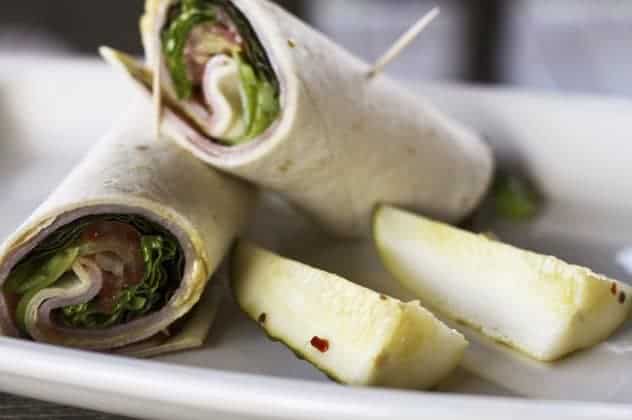
Recipe for Claussen Pickles
What do you need in order to make this recipe for Claussen Half Sour Pickles at home? Let’s get a quick list for both ingredients and equipment out of the way, shall we?
Equipment for Making Claussen Pickles at Home
- A Glass gallon jar or 4 glass quart jars or other food safe container with a tight fitting lid
- Measuring cup
- Chef’s knife or paring knife
Ingredients for Making Homemade Claussen Pickles Copycat
- Small to medium size pickling cucumbers (check your local farm stand or farmer’s market!)
- Apple Cider Vinegar (don’t fret- it doesn’t taste like apple cider and isn’t even a little sweet!) or white vinegar
- Kosher Salt
- Garlic
- Dill (either fresh or dill seed)
- Pickling spices (available here)
A quite note on your vinegar choice: I opt for apple cider vinegar because it’s a smoother vinegar than white vinegar. It does not impart any sweetness or apple taste to the pickles whatsoever.
If you can’t find it (pssst. It’s right next to white vinegar in even moderately stocked grocery stores) or don’t feel like buying it, you can most certainly substitute white vinegar. It’ll just taste a little sharper. (And technically store bought Claussen pickles have white vinegar, so you do you!)
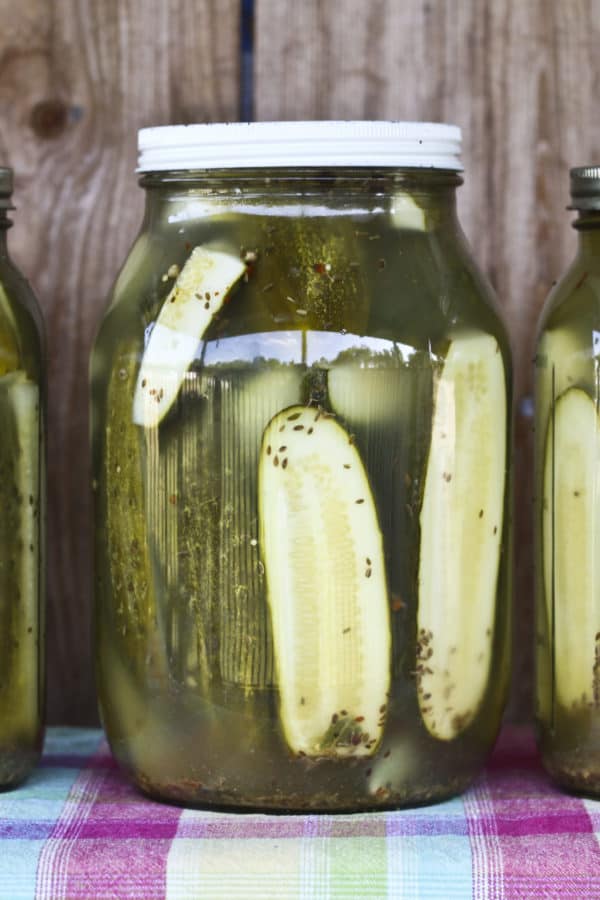
And ya’ll. These homemade half sour pickles are so easy to make it’s almost criminal.
The hardest part is the 2 to 4 day wait for them to be done. Truth be told, though, I’ve snacked on them the day after I made them and been a very happy camper.
Claussen Pickle Recipe
These are homemade refrigerated deli pickles, also known as Lithuanian half-sours, also known (in the commercial equivalent) as Claussen dill kosher pickles, also known as the best pickles ever known to mankind.
Here’s the thing. While I do love my other homemade pickles dearly (otherwise why would I continue canning ninety-something quarts year after year after year), these are by far my all-time favourites.
CRUNCH. That’s what you hear when you bite these. There is no flop, no squish, no soft pickles. These things almost bite back.
This also happens to be the perfect dill pickle recipe for beginning pickle makers. If you’re not into canning, these refrigerator pickles are a godsend. Even if you ARE canning obsessed, like yours truly, this Claussen pickle recipe should be in your pickle repertoire too.
Please note that this Claussen pickle recipe is not suitable for canning. The brine is fermented and not very acidic, which means it has far too high a PH to can safely. If you’re looking for a great canned dill pickle recipe, try this home canned garlic dill pickle recipe.
Refrigerator Pickles
Here’s where we get into the best part of this pickle recipe (aside from the crunch and flavor). You don’t have to cook anything to make these pickles; not one single thing. The brine is stirred together, the cucumbers are rinsed, trimmed and stuffed into a jar with garlic cloves and spices.
These half sour pickles are NOT CANNED. They are simply put into jars. Amen!
When it’s summer time and the idea of turning on the stove makes me want to crawl into an (air conditioned) hole, these pickles are a welcome treat. Not only is that cold crunchy refrigerator pickle waiting to cool me off at the end of the prep time, but I don’t have to heat up my kitchen by even one single degree to get there.
Remember that pickling isn’t just for cucumbers, either! Try out our Pickled Brussels Sprouts, Quick Pickled Red Onions, and famous Candied Jalapenos!
How to Make Pickles FAQ
Please, please, please give these a go even if you have never made a pickle before. There is nothing scary or intimidating here. Wash, slice, stuff, stir, pour, sit, wait.
- Trim 1/8-inch from the blossom end of each cucumber and slice them in half lengthwise or into quarters. The size you choose depends on how large your cucumbers are and how big you want the pickles to be when they’re done. This helps minimize the chances of soft pickles.
- In a gallon jar (or large, wide-mouth, food-safe container) layer the dill heads or seed, pickling spice or mustard seed, and garlic cloves and sliced cucumbers. If you’re dividing the cucumbers up between smaller containers, just divide the garlic and spices evenly between the containers, too.
- Stir your brine together in a separate container. You WILL have more brine than you have space for in the jars, but that’s why you pack the spices in the jars. Just store extra brine in a jar in the refrigerator and use it to top off your pickles if the brine starts evaporating.
- Pour the brine over the cucumbers, taking care to make sure all of them are fully submerged. If needed, place a plate or mug or other ziploc bagged can of beans on the cucumbers to weigh them down and keep them under the brine!
- Cover the jars lightly not tightly and leave out of direct sunlight on the counter for two to four days or until the pickles are picklicious.
- If your kitchen is pretty hot or humid, you can stash them directly in the refrigerator. They’ll just take a couple of days longer to get fabulous. Your patience will be rewarded.
On the plus side, the wait is only two to four days which is significantly less than the six week wait of the canned pickles. Besides, as I said, there is the crunch factor
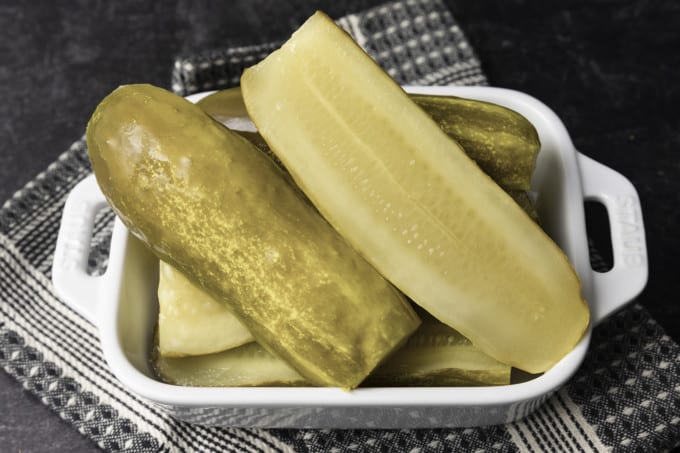
Troubleshooting Your Homemade Claussen Pickles
These pickles are easy peasy to make, but there still may be a couple of things that pop up from time to time that make you go “Hmmm…” In no particular order, here are some of the most commonly asked questions about them and some answers!
- Why is my pickle brine cloudy? Okay, I lied. This is the most common question and that’s because the brine becomes cloudy naturally as a consequence of fermentation (which is what’s happening here.) No worries.
It’s all natural. This half sour pickle recipe (more on this to come) is a fermented pickle recipe and that just happens.
Another possible cause of intense cloudiness or discolouration in your brine is using table salt. The iodine in table salt can also give off flavours to your pickles, so it’s best to stick with kosher salt or pickling salt for these bad boys! - Is the scum, foam, or film on top of my pickle brine dangerous? It’s that pesky (and delicious) fermentation again! This is another thing you don’t have to worry about.
Just scrape it off with a spoon, discard, and top off with a little of that extra brine you whipped up. (See the recipe card for details.) But do remove the scum or it could cause your pickles to go bad. - My pickles went soft! How do I prevent this? This particular tragedy could have two causes.
First, you may have failed to remove enough of the blossom end of the cucumber. There is a naturally occurring enzyme in the blossom end of cucumbers that causes pickles to break down and become soft if it is not removed. Next time, just slice more off.
Second, you may have started with less than spectacularly fresh cucumbers. An older cucumber has had longer for the aforementioned enzyme to kick in, and it has already started its work.
The best solution for this issue is to use cucumbers that have either been picked fresh that day or have been refrigerated steadily since very shortly after being picked a couple of days previously. - Why did my pickles go bad? See that second reason in the “why did my pickles go soft” bullet point? That’s one culprit.
Other potential causes of spoiled pickles are using unwashed cucumbers or fresh dill, old or decayed garlic, bad spices, lower-than-5%-acidity-vinegar, failing to remove the scum from the brine or to keep the pickles submerged in the brine, or storing your pickles in warmer conditions. When in doubt, stash them in the refrigerator! - Why is there mold on my pickles? First, you have my condolences. Second, it’s because your pickles didn’t stay submerged in the brine. That brine has enough salt and acid to prevent mold growth if the cucumbers stay under the surface.
If you’re having trouble finding something that fits in the jar to keep this from happening, try popping a can or two of tomato paste or canned beans in a zipper top bag and gently inserting that into the jar. It should weigh it down enough to do the job. - Should I worry about the white sediment in my jar? This is another one in the “don’t sweat it” category. There are two potential reasons and both are completely harmless.
It’s either a natural consequence of the fermentation or anti-caking agents in the salt. Neither harms the pickles or effects the flavour, so don’t worry! - Why is my garlic blue/green/purple? As long you inspect the garlic before it goes into your jars and it is fresh as a daisy, you have nothing to worry about. It could be the type of salt you used or it could be the variety of garlic. Some types of garlic have a natural propensity to change pretty colours in vinegar.
It also may mean that your pickles were exposed to light. When garlic is exposed to light, it starts producing chlorophyll which is green. It also may indicate that your garlic is more mature.
In that case it is caused by sulfur compounds that naturally occur in more mature garlic reacting with minute traces of copper in the vinegar., but as long as there are no other signs of spoilage (soft or squishy texture, funky smell, discoloured spots), you’re good to go.
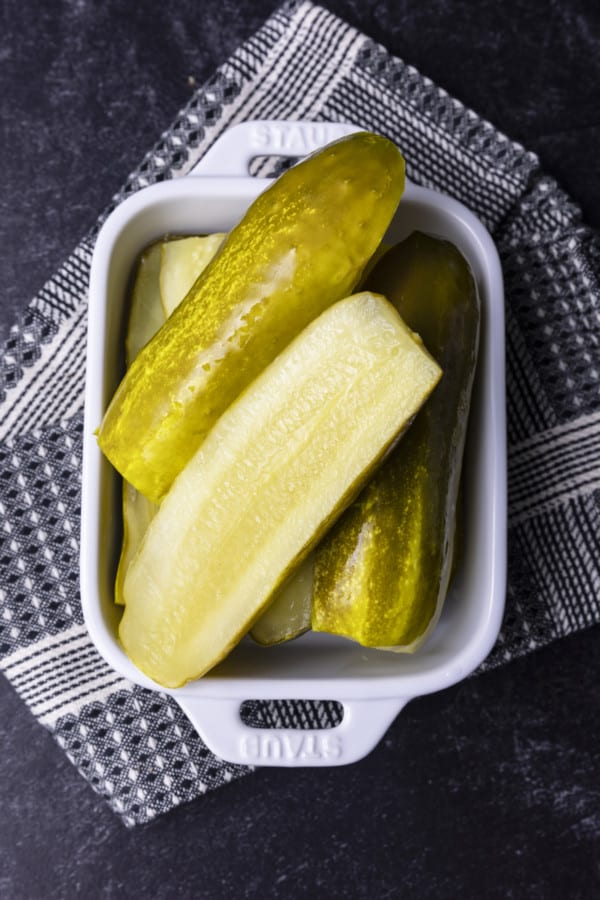
IMPORTANT NOTE: Because there is so much diversity in temperature, humidity, age of cucumbers, etc… involved in this recipe, please check your half sour pickles starting at 24 hours for doneness. If the pickles smell/taste pickley, move them to the refrigerator. Do not keep them on the counter longer than 4 days.
ANOTHER IMPORTANT NOTE: These pickles are not suitable for canning. They’re simply not acidic enough to can safely, and that is in addition to the fact that you’d ruin that perfectly crisp texture by introducing heat to the party.
What can I serve with these Homemade Claussen Knock-Off Pickles?
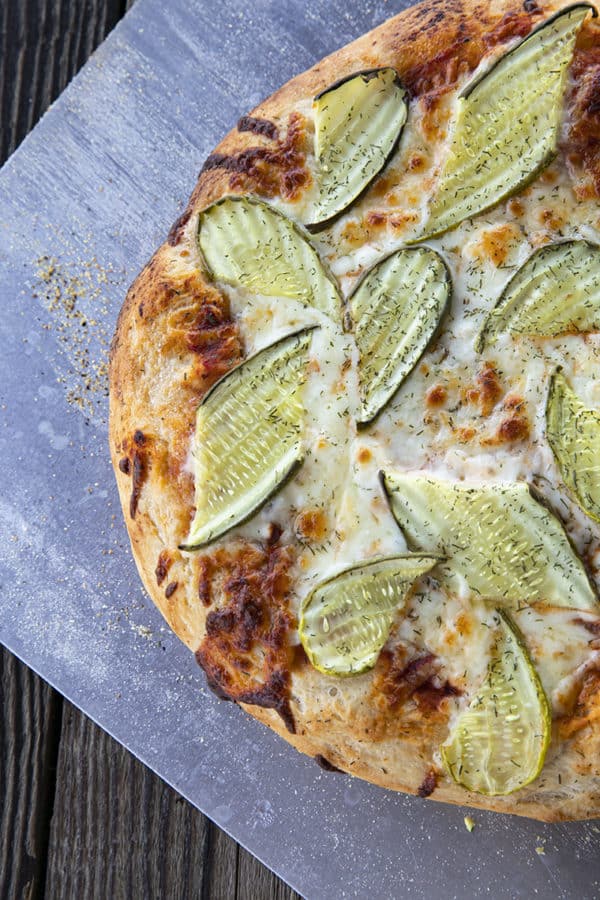
Start out by trying your half sour pickles in this Pickle de Gallo, Dill Pickle Dip, Dill Pickle Egg Salad, or Bagel Burgers with Dill Pickle Cream Cheese.
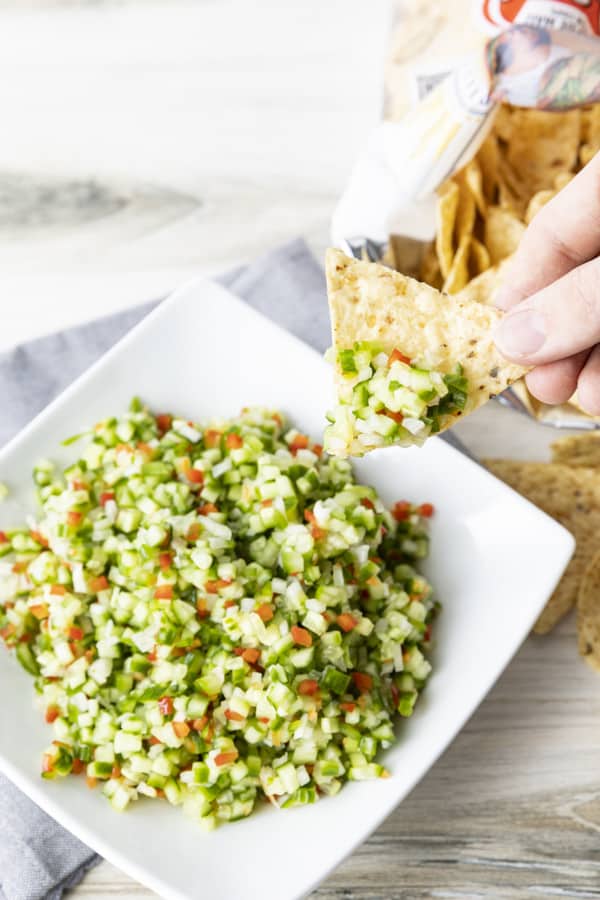
Even better, serve them on our Cheeseburger Salad or Pickle Pizza.
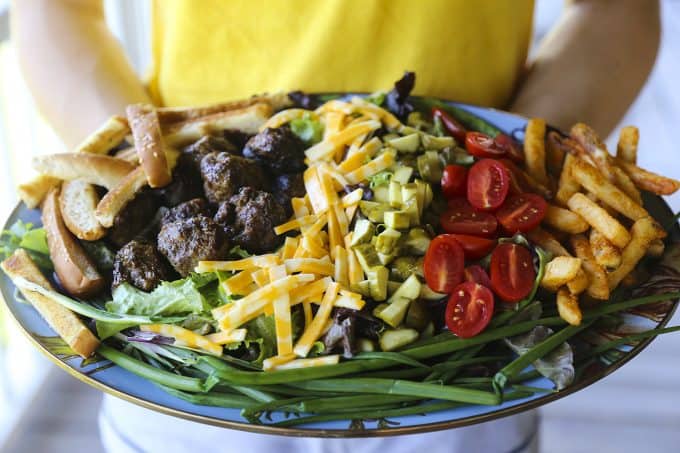
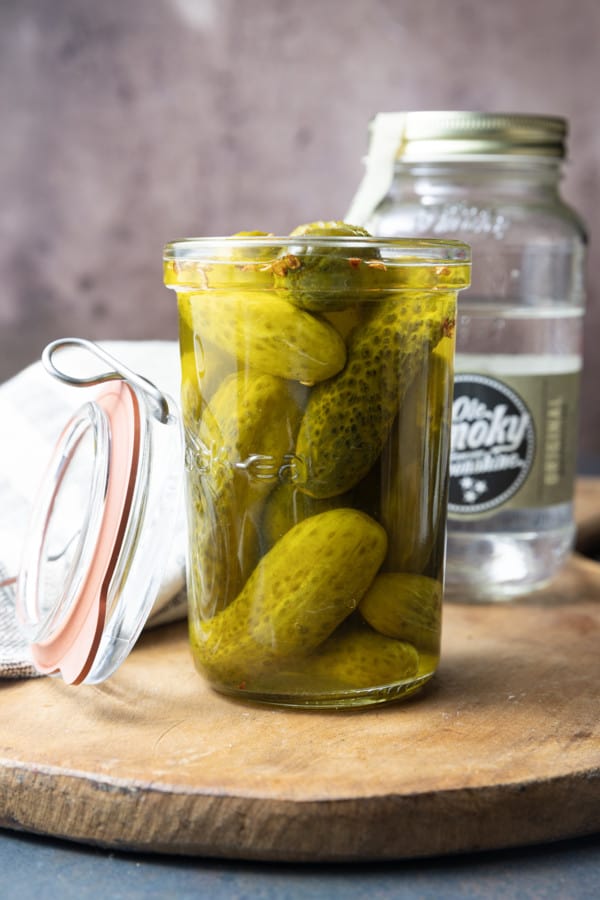
You can even take extra pickles (like that’s a thing!) and make these divine Moonshine Pickles. You’ve never had a better Bloody Mary than one made with homemade Moonshine Pickles!
Half Sour Pickle Recipe
What makes Claussen PIckles different from canned pickles? Claussen pickles, whether homemade or store bought, are a half sour pickle recipe.
That means they’re fermented instead of heat processed. That’s what gives them such great texture.
This half sour pickle recipe yields pickles that are crunchy to the point of making noise when you bite them, cold, and seriously garlicky. Canned, shelf-stable pickles can be chilled, maintain some crunch, and be as garlicky as you want them to be, but they are never, ever going to be the same thing because of science.
When you heat process a jar of pickles you are, in actuality, cooking it and a cooked pickle just plain can’t be as crunchy as an un-cooked half sour pickle recipe.
These homemade pickles keep well in the fridge for about six months, as long as they remain submerged in the brine. In our house, they never last that long because, as the saying goes, “A pickle a day keeps sad times away.”
They say that right? Someone must. If not, I’m going to start. It’s true, after all.
Claussen Pickles
Wash cucumbers but do not scrub them.
Trim 1/8-inch to 1/4-inch from the blossom end of each cucumber and slice in half lengthwise or into quarters, depending on how large your cucumbers are and how big you want them to be when they’re done.
Layer the dill heads or seed, garlic cloves, pickling spices and sliced cucumbers in a gallon jar (or large, wide-mouth, food-safe container). You can evenly divide the dill, garlic cloves, pickling spices, and cucumbers between several smaller jars if needed.
In a separate pitcher or bowl, stir together the remaining ingredients until the salt is dissolved.
Pour the brine over the cucumbers, taking care to make sure all of them are fully submerged. If needed, place a plate or mug or other non-reactive heavy item on the cucumbers to weigh them down and keep them under the brine!
Cover lightly with a lid just perched on top or secure a piece of cheesecloth over the jar with a rubber band to keep fruit flies away. Store any extra brine in a covered jar or pitcher in the refrigerator and use it to top off the brine if it starts to evaporate and expose the pickles to the air.
Leave out of direct sunlight on the counter for at least 24 hours, but up to 4 days, or until the cucumbers taste like pickles throughout.
Fix your lid onto your jar or container and chill thoroughly. These can be stored in the refrigerator for up to six months provided you keep them covered with brine.
NOTE: If at any point in the proceedings “fuzz” or “foam” develops on top of the brine, use a spoon to remove it. If there is “fuzz” attached to any of the cucumbers, remove the ones affected and be sure the others are still fully submerged.
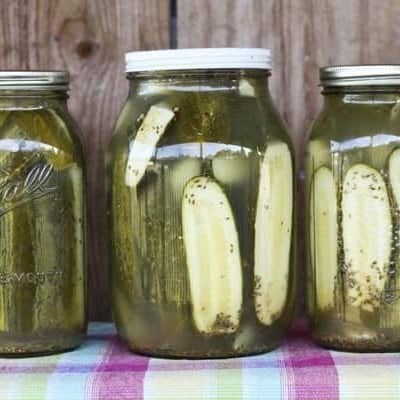
Homemade Claussen Knock-Off Pickles
Equipment
- 1 gallon jar or 4 quart jars or a large, food-safe container with a tight fitting lid
- 1 liquid measuring cup
- 1 large mixing bowl or pitcher
Ingredients
- 35 to 40 small to medium pickling cucumbers
- 1 gallon cold water
- 1 cup apple cider vinegar, preferably raw or white distilled vinegar
- 2/3 cup coarse canning or kosher salt Do NOT fine or use iodized salt!
- 4 cloves garlic or more to taste
- 4 heads fresh dill or 4 tablespoons dried dill seed not weed!
- 2 tablespoons mixed pickling spices
Instructions
- Wash cucumbers but do not scrub them.
- Trim 1/8-inch from the blossom end of each cucumber and slice in half lengthwise or into quarters, depending on how large your cucumbers are and how big you want them to be when they’re done.
- In a gallon jar (or large, wide-mouth, food-safe container) layer the dill heads or seed, garlic cloves, pickling spices and sliced cucumbers.
- In a separate pitcher or bowl, stir together the remaining ingredients until the salt is dissolved.
- Pour the brine over the cucumbers, taking care to make sure all of them are fully submerged. If needed, place a plate or mug or other non-reactive heavy item on the cucumbers to weigh them down and keep them under the brine!
- Cover lightly with a lid just perched on top or secure a piece of cheesecloth over the jar with a rubber band to keep fruit flies away.
- Leave out of direct sunlight on the counter for two to four days*, or until the cucumbers taste like pickles throughout.
- Fix your lid onto your jar or container and chill. These can be stored in the refrigerator for up to six months provided you keep them covered with brine.
- *If at any point in the proceedings “fuzz” or “foam” develops on top of the brine, use a spoon to remove it. If there is “fuzz” attached to any of the cucumbers, remove the ones affected and be sure the others are still fully submerged.
Notes
Nutrition
Nutritional information is an estimate and provided to you as a courtesy. You should calculate the nutritional information with the actual ingredients used in your recipe using your preferred nutrition calculator.
did you make this recipe?
Make sure to tag @foodiewithfam on Instagram and #hashtag it #foodiewithfamily so I can check it out!
Originally published July 22, 2011. Updated with FAQs and Troubleshooting and reposted August 2022.
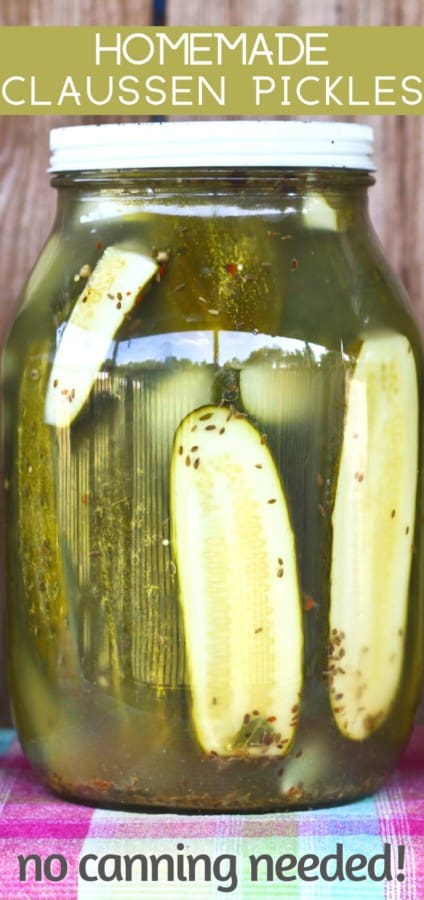
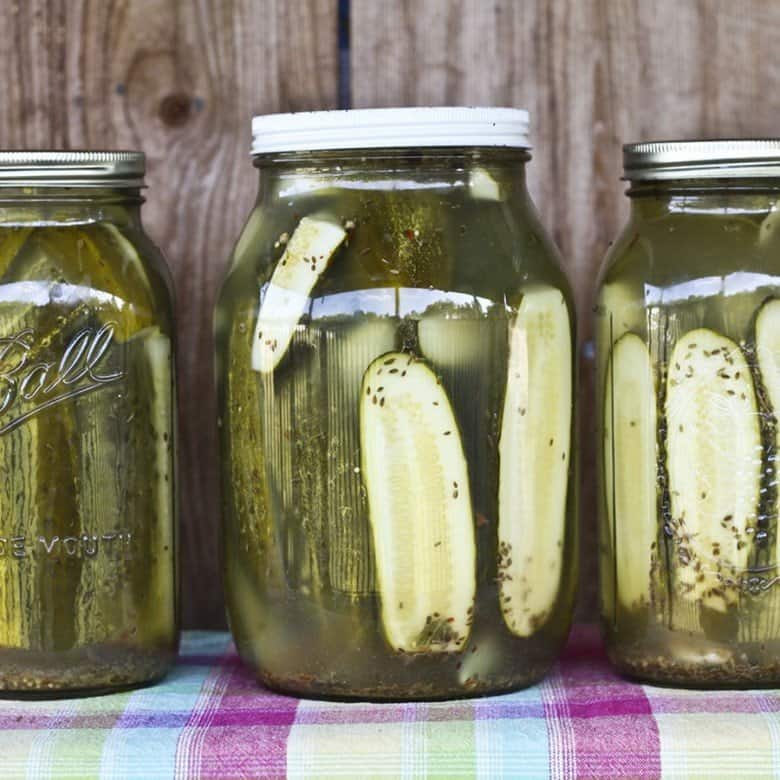
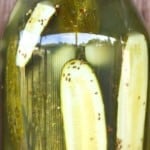



Reader's Thoughts...
Kyle A Beverley says
How long do the keep in the fridge? I imagine they don’t come out of the fridge, are they shelf safe?
Rebecca says
Hi Kyle- You’re correct that they do not come out of the fridge for storage; they are not shelf stable. They should be good up to 3 months in the refrigerator.
Paul Scott Kaminsky says
Be careful with store bought pickling spices. A major spice manufacturer (Mc you know) has a lot of cinnamon and cloves as fair portion of their ingredients. Me thinks that those two do not belong in dill pickles.
Mary says
Can I do this with ex large cukes? Can I cut them in pieces, or slices?
Rebecca says
Hi Mary- If they’re picklers and they’re fresh, I’d give it a go. If you try it, please let me know how they turn out for you!
Scott says
I definitely want o make these, but I do not like cider vinegar at all, I want to use distilled white vinegar, I’m hoping it will still be the same measurement of vinegar to water. Claussen pickles are my absolute favorite pickle and I do know that it has white vinegar not cider vinegar so I think it will work the same.
Rebecca says
Hi Scott- You can substitute an equal amount of distilled white vinegar for the cider vinegar, certainly!
Jeffrey Hess says
How long do they keep in the fridge?
Rebecca says
Hey Jeffrey- I’d say they’d be good for about 1.5 months… they may last longer, but might suffer a little texturally after that!
Jessica says
I’ve had my pickles in the fridge for about 2 months and there’s a white filmy looking stuff on the very top. It doesnt look fuzzy like mold, though. Could I just skim that off and eat the pickles or should I throw the whole batch out? Thank you!
Rebecca says
Hi Jessica- I think you should be fine. If I’m correct, that’s a film of yeast at the top which is common in fermented vegetables. If it smells or tastes funny, though, I’d pitch it! Of course, that’s my educated guess not actually having seen it, so please proceed according to your own comfort level.
Sheila Wiggins says
it is so easy and they are so awesome thank you for this recipe
Rebecca says
Thank you, Sheila!
Sam says
I halved this recipe as I had only 20 pickle cukes. I must say I thought the amount of salt was high when I read the recipe. Halving 2/3 c gave me 1/3 c to out in. I tried the pickles on day 2 of the bribing process and wowza were they salty! Thought my heart was going to beat out of my chest. I then went and read similar recipes on the web and they only use about a tsp or so. What are you thinking with this much salt? Absolutely horrible. To save my pickles I gave them a rinse and added fresh water and all other ingredients. Except salt thinking they still retained salt. Fortunately on day 4 I tasted again and a lot better.
Can you please explain why so much salt in this? Thanks
Rebecca says
Hi Sam-
I need to first ask whether you mixed the salt into the water as instructed, then poured the resulting brine over the pickles. If you added the salt directly to the jar, it would be inedibly salty. The salt is first diluted in the water/vinegar mixture and not all of it even makes it into the pickle jars… there is almost always some left over and reserved to top off the jars if they start to evaporate.
Second, I need to confirm whether you used coarse kosher salt or canning salt. If you used iodized table salt or sea salt, you added far more salt (weight wise) than the equivalent volume of coarse kosher salt would have yielded. In other words, it would have yielded an inedibly salty result again.
I suspect the pickle recipes you were looking at online called for adding teaspoons of salt per quart jar and not one teaspoon to a gallon of water and cup of vinegar. There are many different sorts of pickles, but this is a classic sour or fermented pickle that requires salt as part of the preservative/texturing process.
Sam says
Hello
Thanks for the reply. I did mix the kosher salt with the water until it dissolved before pouring over the pickles. Not sure if it was course or not. Will have to check the box. I believe it was. I followed the directions to the letter; just cut all ingredients in half.
I ended up draining the brine after I had tasted it. Made a new brine with a tbsp of kosher salt and put the jars in the fridge. After 2 days all was well. Tasted fine and less salty.
I believe the tsp of salt I saw was in a different type pickle.
Rebecca says
Hi Sam- Thanks for getting back to me. I’m not sure where this went wrong for you. This is a pretty dead-on copy-cat of Claussen style pickles, so if you like the salt level in those, you should like these pickles. It’s a big mistake to taste it the day you’ve made it, though. The real test comes on day 4 or 5, and you have to taste the cukes, not the brine. The brine is always going to be salty; that’s the preservative effect of it. And sadly, brines are not interchangeable for different types of pickles. As I mentioned, these are a fermented style cucumber and the level of salinity is designed to encourage just the right amount of lacto-fermentation. Much more and you’ll encourage salt loving yeast growth (which would be nasty) and much less and you’ll encourage bacterial growth (also undesirable). 🙂
Brenda says
Is it supposed to taste so salty when it’s first made
Rebecca says
Hi Brenda- Can you let me know what type/brand of salt you used?
Brenda says
Mortin coarse kosher salt
Rebecca says
Okay, my next question is whether you mixed the salt in with the water or put it directly in the jar?
Wayne Tortora says
HELP!! I have cloudy brine and MUSHY pickles, what did I do wrong??
Rebecca says
Hi Wayne- Cloudy brine isn’t a problem- that’s a sign it’s fermenting. The mushy, though, that’s sad! It could be that the cucumbers were picked a while before the pickles were made, or that there was an issue with the enzyme that causes breakdown (mushiness) of the cucumber being activated, or that the blossom end wasn’t sufficiently trimmed, or that you may have used the wrong type of cucumber. It’s hard for me to know without being there. I’m sorry! How’s the taste (I mean- I know the texture is off… but what’s the flavour like?)
Deb Skalecki says
can I use regular cucumbers instead of pickling cuks? I bought seed that the package said was English Cucumber (the picture showed long narrow cucumbers) which is what I wanted. What I’m getting are very seedy, fat cucumbers! They are turning yellow before they get very big. Not happy at all, but I don’t want to throw all these away.
Rebecca says
Hi Deb- Ooof. The yellow makes me wonder if there’s some kind of weird cucumber blight going on for you. I had that happen a few years ago. All of my cucumbers turned weirdly yellow with a thick skin and were fat. They tasted awful, too! Even my chickens didn’t want them. Have you tried slicing and eating them? I’d hesitate to pickle them en masse, but would try it with a small batch.
Elizabeth Shimwell says
Is it 2/3 cup of salt? I used that and my pickles are WAY too salty. Any tips? Thank you for your help. 🙂
Rebecca says
Hi Elizabeth- Can I ask which brand/style of salt you used? Because the 2/3 cup is correct when using Morton’s coarse kosher salt. And as the salt is dissolved in the water before being added to the jars (and not all of the brine makes it into the jars), it won’t end up being all of that salt in there.
Susan Morgan says
Can’t wait to see how they taste!
Nori McKenna says
If I make these pickles in a crock,after 4 days ,should I put them in the fridge?
Rebecca says
I transfer them from the crock (if it’s too large for the refrigerator, and I do have a 5 gallon crock!) into jars for refrigerator storage. 🙂
Merle Sallee says
Have made these for a couple years, they are delicious.
Rebecca says
I’m glad you love them, Merle. Thank you for the excellent rating!
Dawn says
Love. Love. Love this recipe. So do my pickle snob family and friends. I cut them into spears and were they crunchy!!! I added more dill and garlic. Yummy!!
Rebecca says
I’m so glad you love them, Dawn! Thanks for the love!
Nori S McKenna says
This is my 2nd year making these pickles! Everyone LOVES, them!!! My next batch is going into a nice big crockery pot.My friend &family request these delicious pickles every time they come over.Thanks so much for sharing your AWESOME RECIPES WITH THE WORLD! Sincerely, Norimckenna@gmail.com ?
Rebecca says
Thank you, Nori! I appreciate the love and the feedback. I really do!
Debota says
It is garden season .cukes comming in.I have never made pickles before .this recipe looks easy.thank you for shareing .
Tim says
Hi!
Thank you for sharing the recipe and your experiences. We make our own pickles here in Russia though I ate tons growing up in Alabama and Georgia. Over here pickling is a way of life so I was glad to find your vlassic recipe!
However you gave a vague statement in regards to the pickling spice. What s in the pickling spice because as you know there are countless various mixtures.
Looking forward to hearing from you!
Blessings,
Tim and Larisa Tyson
Ginny says
Can you do this with whole pickles?
Rebecca says
I’ve done it before, but prefer the halved cucumbers because I think they absorb flavours better!